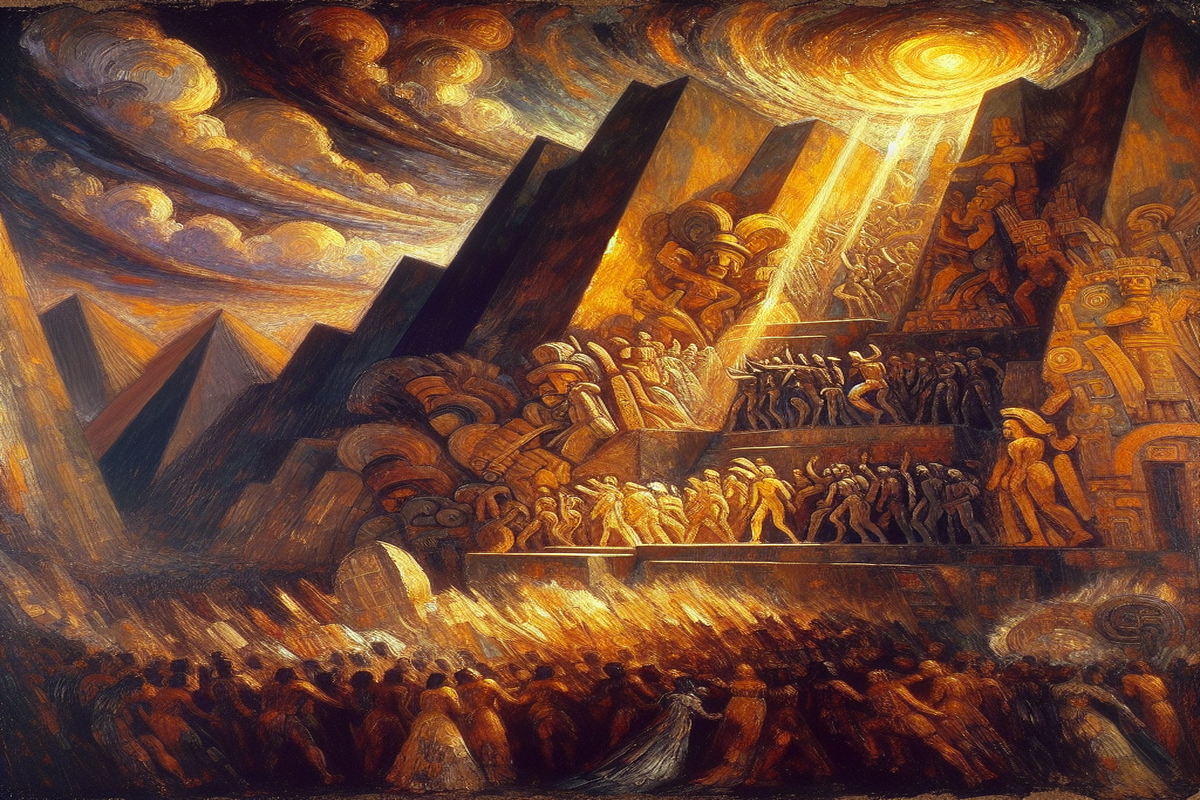What is Monte Albán
Monte Albán is one of the great ceremonial centers of Mesoamerica, located in the Oaxaca Valley, Mexico. It was the capital of the Zapotecs, a city planned atop an artificial hill, and functioned as a political, religious, and economic nucleus from the Formative period through the Classic and early Postclassic eras.
Origin and chronology
The earliest settlements at Monte Albán date to roughly 500 BCE, although human occupation in the valley is older. The city reached its height between 200 and 800 CE, when it consolidated as a regional center. Its different periods show transformations in architecture, social organization, and artistic expressions.
Urbanism and city design
The main plaza, built on an artificial platform, structures the urban layout, surrounded by ceremonial buildings, palaces, and mounds. Monte Albán’s plan reflects a collective project, with areas dedicated to worship, administrative power, and elite residence. The visibility from the hill reinforces its symbolic and strategic role.
Architecture, mounds, and courts
Notable features include broad plazas, terraces, and ballcourts—evidence of ritual practices shared across Mesoamerica. The mounds and platforms support buildings with façades now interpreted as ceremonial, administrative, or high‑status residential spaces.
Art, stelae, and the so‑called “Dancers”
Monte Albán is famous for its carved stelae, with figures known as the “Dancers,” which depict scenes of prisoners, ritual actors, or event lists. These sculptures offer clues about worldview, warfare, and political control. Local iconography interacts with other traditions of the valley and neighboring regions.
Writing and historical records
The Zapotecs developed record systems combining calendrical signs and glyphs—elements that allow partial reconstruction of their history and genealogy. Full decipherment of these signs remains under investigation but has contributed to understanding state administration and ideology.
Ritual functions and tombs
Excavations have revealed tombs with offerings, grave goods, and human remains, indicating complex and hierarchical burial rituals. Many of these tombs contain grave goods such as shells, ceramics, and metal objects, testifying to exchange networks and regional prestige.
Relations with other cultures
Monte Albán maintained contacts with centers of the Central Valleys, the Oaxaca Coast, and more distant regions. Those links are reflected in ceramic material, iconography, and ceremonial practices. The city operated as a hegemonic center that influenced cultural patterns in southern Mesoamerica.
Archaeological methods and absolute chronologies
Dating at Monte Albán combines stratigraphy, ceramic typology, and absolute techniques such as radiocarbon dating. For those of us interested in deep‑time research, topics like fossil dating and paleontology provide conceptual tools that, although applied to different materials, share methodological principles.
Rock art and pre‑Hispanic symbolism
Monte Albán’s iconographic repertoire converses with other graphic expressions of the past, such as rock paintings. Both forms, though on different media, show how ancient societies expressed myths, agricultural cycles, and collective narratives to legitimize power.
Conservation and modern challenges
The preservation of Monte Albán faces challenges from erosion, urban growth, and the need for responsible archaeological intervention. Heritage management requires public policy, ongoing research, and community participation to ensure the site is passed to future generations.
Museums and public outreach
Museums are allies in interpreting Monte Albán, facilitating access to archaeological material and contextualizing findings for the public. From our perspective at the Mamut Museum of Tultepec, we promote scientific outreach and have addressed exhibition and museographic experience topics in posts like digital museums of Mexico and art museums in Mexico, where cultural mediation strategies are discussed.
Monte Albán and public interpretation
Seeing a main plaza, a monumental complex, or a stela in its original context is a different experience than viewing it in a display case. Public interpretation should combine scientific data, accessible narratives, and respect for present communities, many of which maintain cultural ties to the ancient inhabitants of the valley.
Heritage, tourism, and community
Cultural tourism generates resources and pressures; therefore, it is essential to balance conservation and economic development. Local communities and academia must collaborate to define sustainable practices that allow enjoyment of the site without sacrificing its integrity.
Connections with megafauna studies and ancient landscapes
My training and passion for paleontology lead me to view Monte Albán as part of a landscape that changed over time. Research on fossils and remains that reveal the past and studies of megafauna help reconstruct ancient climates and vegetation—factors that conditioned human settlement and exchange routes.
Why Monte Albán still matters
Monte Albán is not just a set of ancient stones; it is a monumental archive on social organization, beliefs, and power relations in southern Mesoamerica. Its study continues to offer lessons about ancient urbanism, cultural interaction, and resilience in changing landscapes.
Visiting and learning
A visit to Monte Albán allows connection with a long history visible in plazas, tombs, and reliefs. For those of us working in museums, every stone is an opportunity to teach scientific methods, show conservation processes, and link past and present through concrete stories.
Knowledge of Monte Albán is built through excavations, analysis, comparisons, and dialogue. As Mexicans interested in the planet’s history and ancient life, we find in sites like Monte Albán bridges between archaeology, paleontology, and cultural outreach—topics we continue to explore in posts like prehistory and the mammoth of Tultepec: curiosities about mammoths.


